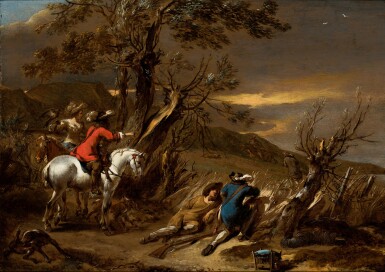Quality in Detail. The Juli and Andrew Wieg Collection
Quality in Detail. The Juli and Andrew Wieg Collection

Nicolaes Berchem
A falconry party in a landscape
Lot Closed
March 24, 03:24 PM GMT
Estimate
8,000 - 12,000 GBP
Lot Details
Description
Nicolaes Berchem
Haarlem 1621/22 - 1683 Amsterdam
A falconry party in a landscape
signed lower left: NBerchem (NB in ligature)
oil on oak panel
unframed: 30 x 43 cm.; 11 3/4 x 16 7/8 in.
framed: 45.8 x 58.4 cm.; 19 1/4 x 23 in.
Sale (W. Smits and others), The Hague, 18 May 1785, lot 168, for 42.15 Dutch Florins to Spruyt;
Probably acquired from John Smith (1781-1855), London, in 1825 by
Lord Francis Egerton, later 1st Earl of Ellesmere (1800-57), Bridgewater Gallery, Bridgewater House, London, and sold by him after 1834 and before 1851;
With Kunstzaal St. Lucas, The Hague, by 1953 (when exhibited at the antique fair, Delft);
Private collection, Sweden;
Anonymous sale, Stockholm, Bukowskis, 30 October 1990, lot 228, to De Boer;
With Kunsthandel P. de Boer, Amsterdam, from whom acquired for the Wieg collection in 1994.
Catalogue of the pictures belonging to Lord Francis Leveson Gower, 1830, no. 184;
J. Smith, A catalogue raisonné of the works of the most eminent Dutch, Flemish, and French painters, vol. V, London 1834, pp. 90-91, no. 284;
C. Hofstede de Groot, Beschreibendes und kritisches Verzeichnis der Werke der hervorragendsten Holländischen Maler des XVII. Jahrhunderts, Esslingen 1926, vol. IX, p. 96, no. 159;
P. Humfrey, The Stafford Gallery. The greatest art collection of Regency London, Norwich 2019, p. 239 and p. 316, Appendix D ('Paintings added to the Bridgewater Collection by Lord Francis Egerton)', no. 5 (with erroneous Bridgewater inventory number and Sutherland provenance).
Pieter Claesz. Berchem (1596/7-1660), the father of Nicolaes, took his name from his city of origin - Berchem, near Antwerp, and later settled in Haarlem, where Nicolaes was born. Nicolaes studied under his father, and later with Jan van Goyen (1596-1656), Claes Moeyaert (1591-1655), and Pieter de Grebber (c.1600-c.1653). He first experimented with history and religious paintings, but his career started to flourish when he shifted to pastoral landscapes, a genre in which there was less competition in the Haarlem art scene.
Later in his life, after the death of Philips Wouwerman (1618-68), Berchem started working on cavalry battles and hunting scenes, such as the present work. Picking up where Wouwerman had left off, Berchem was able to replicate his commercial success by intelligently borrowing aspects of Wouwerman's compositions in his own interpretations.
